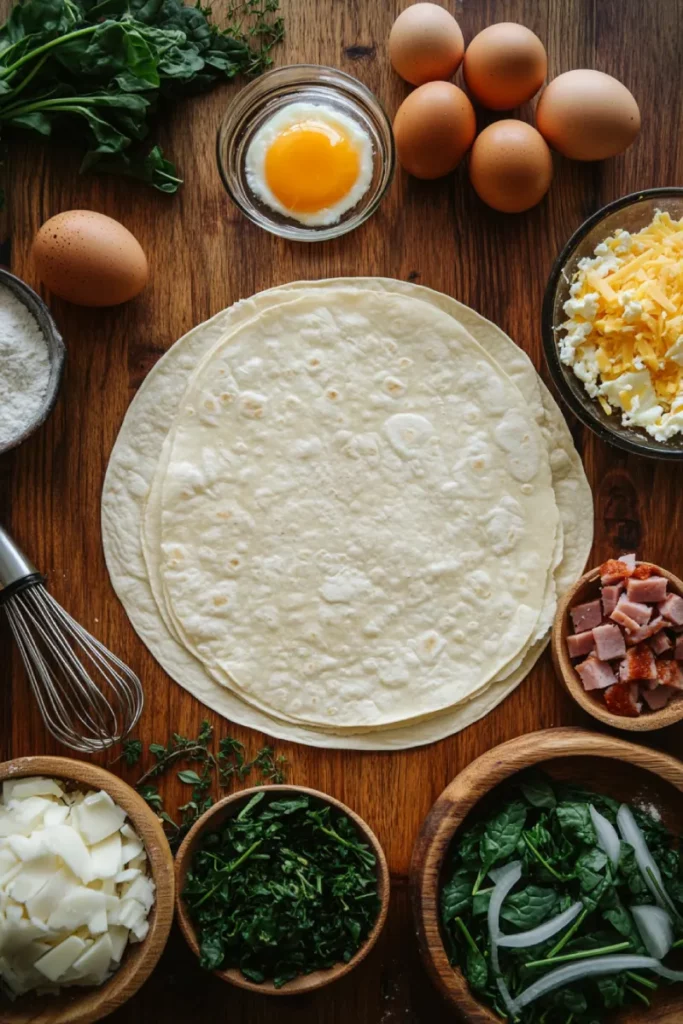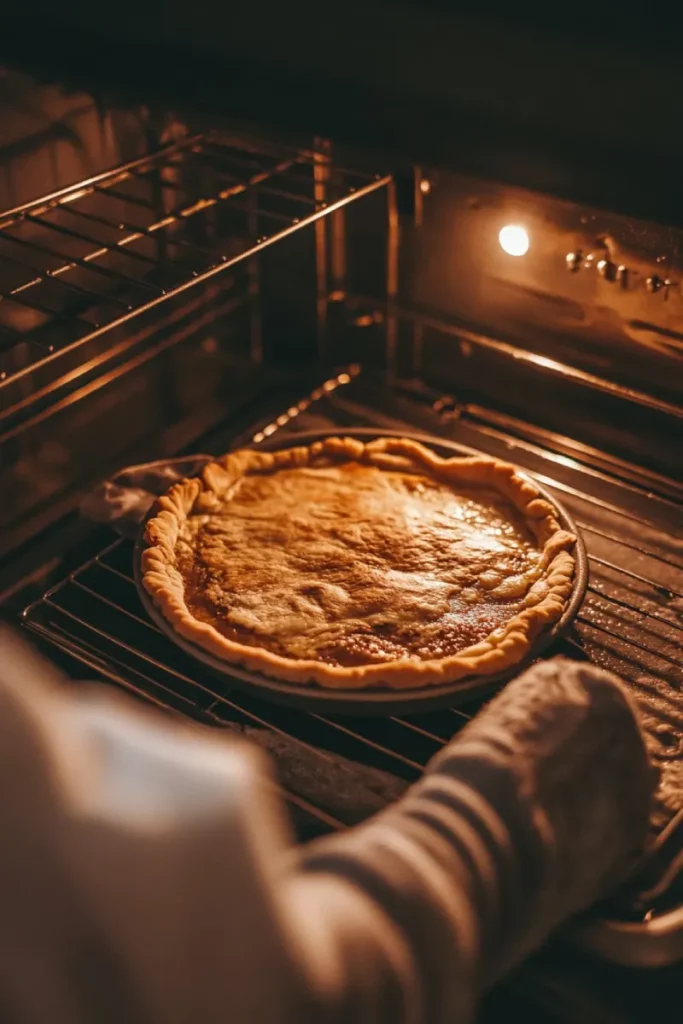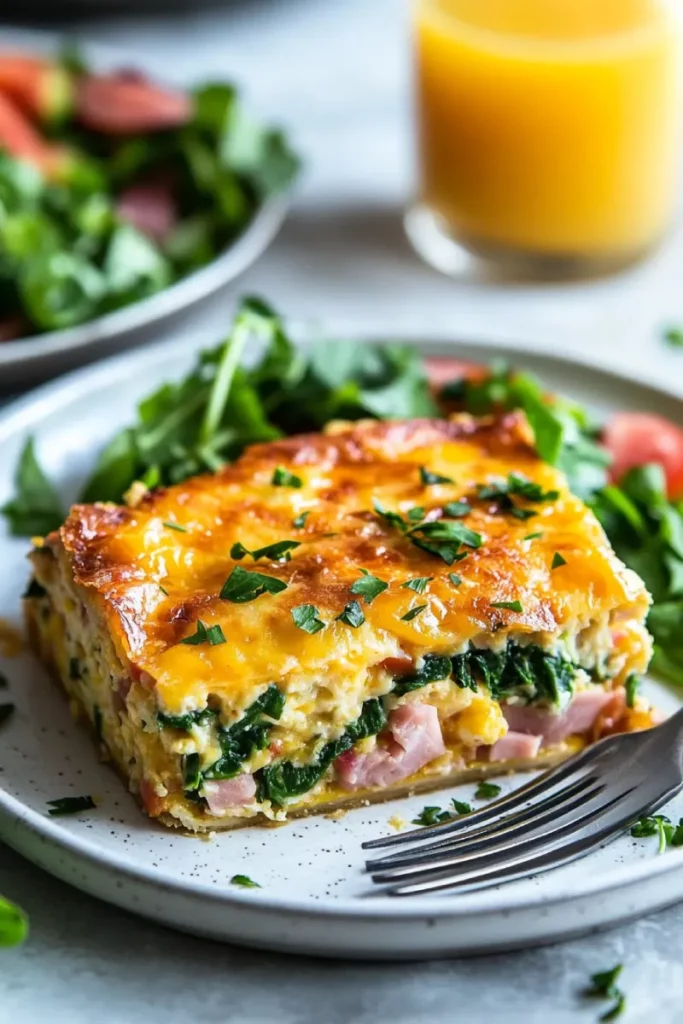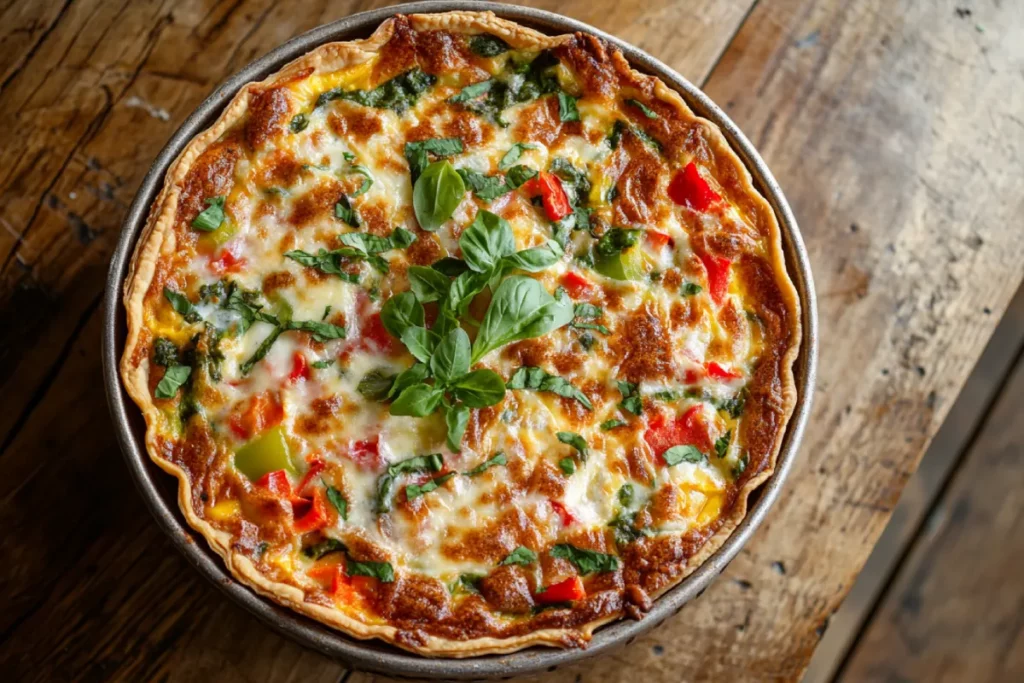Quiche doesn’t have to be fussy or time-consuming. If you’ve ever wondered whether you can skip the pie crust and still get golden, savory results, the answer is yes—a tortilla quiche bake is the shortcut that brings flavor and crunch without the prep work. Using tortillas as a base offers a fast, crispy alternative that works well for breakfast, brunch, or even weeknight dinner. This article breaks down exactly how to make it, what temperatures to use, how to avoid a soggy crust, and which ingredients make the most sense. Whether you’re new to baking quiche or just tired of rolling out dough, this guide shows you how a simple tortilla can change your quiche game.
Bold Tortilla Quiche Bake Idea That Saves Time
Why tortillas make a great quiche base
Tortillas are a smart, practical alternative to traditional quiche crust. They’re thin, flexible, and easy to shape into a pie or baking dish. When baked, the outer edges crisp up while the bottom stays just firm enough to hold the filling without falling apart.
The biggest reason people choose tortilla quiche bake over the usual crust? Time. There’s no need to mix, chill, or blind-bake dough. Just press a large tortilla into a greased pie dish or baking pan and you’re ready to go. Whole wheat, flour, and even low-carb options all work depending on your dietary needs.
Tortillas also bring a mild, toasty flavor that complements both savory and slightly sweet ingredients like caramelized onions or roasted peppers. With less fat and fewer steps than pastry crusts, tortillas make the quiche more accessible for everyday cooking.
How tortilla texture changes during baking
As the tortilla bakes, it undergoes a clear transformation. The edges begin to crisp up, turning golden and slightly wavy. This creates a shell-like crust that gives a satisfying crunch. The center, layered with the egg mixture, becomes soft but stable—not soggy if done right.
The crisping effect depends on how the tortilla is placed and how long it’s in the oven. A tight fit in the dish helps shape the crust neatly, while a slight pre-bake of about 5 minutes can set it up for better texture once the filling is added.
Here’s a quick comparison table showing what you can expect from tortillas versus classic pie crust:
| Feature | Tortilla Quiche Bake | Traditional Pie Crust |
|---|---|---|
| Prep Time | 2–3 minutes | 20–30 minutes |
| Texture | Crispy edges, soft center | Flaky throughout |
| Flavor | Toasty, neutral | Rich, buttery |
By choosing tortillas, you skip the chill time, the dough mixing, and the flour mess. You still get a delicious, structured base with less effort.
Tortilla Instead of Pastry? Here’s What to Expect
Can you swap puff pastry for tortilla wraps?
Yes, and the results are surprisingly good. Swapping traditional pastry for tortillas in a tortilla quiche bake isn’t just about saving time—it also changes the overall experience. Tortillas bring a thinner, crispier bite compared to puff pastry or shortcrust. This swap makes quiche feel lighter, less greasy, and more casual.
For example, if you’re making a light brunch or planning a quick dinner with ingredients you already have, tortillas are easier to manage. They don’t puff up like pastry, but they do hold shape well, especially when baked in a standard pie or tart pan.
Looking for more easy swaps in baked dishes? This biscoff cheesecake also plays with texture in unexpected ways—great inspiration if you love rethinking classic formats.
Taste and structure comparisons with traditional crusts
Traditional crusts made with butter and flour offer a rich, flaky bite. They soak up some of the quiche’s egg mixture, which can either be good (for flavor) or bad (if it turns soggy). Tortillas, on the other hand, resist moisture a bit better. When baked properly, the bottom of a tortilla quiche becomes chewy while the edges crisp to perfection.
That said, you may want to double-layer the tortilla base for added thickness, especially if using very runny fillings like heavy cream or sautéed spinach. Simply overlap two tortillas in the dish and press down firmly so they stick together.
For a crust that surprises guests but still delivers on comfort, tortillas strike the right balance between flavor, structure, and convenience. It’s a technique that feels just as innovative as this matcha latte recipe—unexpected but easy to love.
Tortilla Quiche Bake Temperature Guide
Ideal baking temperature for tortilla-based quiche
Getting the temperature right for a tortilla quiche bake is key. Since tortillas brown and crisp faster than traditional crusts, the ideal oven temperature is slightly lower than classic quiche recipes. Preheat your oven to 350°F (175°C) for the best results. This ensures the egg mixture sets evenly while the tortilla edges turn golden and crispy without burning.
Some recipes go higher—around 375°F—but that can lead to burnt edges or a dry filling. If your oven tends to run hot, stick with 325°F and increase the baking time slightly.
Always use the middle rack and avoid convection settings unless you’re experienced with them. A steady, even bake is the goal here.
Inspired by lighter oven techniques? The same low-temp principles apply in dishes like air fryer frozen chicken wings, where precision makes all the difference.
Adjustments based on filling ingredients
If your quiche is packed with moisture-rich ingredients like tomatoes, spinach, or mushrooms, a longer bake at a slightly lower temp helps avoid a soggy base. For fillings with pre-cooked meats or firmer veggies, you can safely keep the bake at 350°F and reduce cook time to about 30–35 minutes.
Here’s a quick reference chart:
| Filling Type | Recommended Temp | Approx. Bake Time |
|---|---|---|
| Heavy veggies (e.g., mushrooms, spinach) | 325°F (163°C) | 40–45 mins |
| Cooked meats & firm veg | 350°F (175°C) | 30–35 mins |
| Cheese-heavy filling | 350°F (175°C) | 30–40 mins |
Let the quiche rest for 10 minutes after baking to finish setting and make slicing easier.
Need a strong, flavor-packed example of moisture control in cooking? Check out this spicy Cajun cream scallops dish that balances heat and texture brilliantly.
How to Avoid a Soggy Tortilla Crust
Common mistakes and how to fix them
One of the biggest concerns with tortilla quiche bake is ending up with a soggy bottom. Tortillas can absorb moisture from the egg mixture if not handled correctly. But with a few simple tricks, you can keep that crust crisp from edge to center.
Here’s where people often go wrong:
- Skipping the pre-bake: Always prebake the tortilla for 5–7 minutes at 350°F before adding the filling. This helps set the base and gives it a head start.
- Using raw veggies: Raw vegetables release water as they cook. Always sauté ingredients like spinach, onions, and mushrooms before adding them.
- Pouring too much filling: Overfilling leads to undercooked eggs and a wet base. Aim for a filling depth no more than ¾ full in your baking dish.
This same principle—avoiding water overload—applies to sweet dishes too, like the heaven on earth cake where layering prevents sogginess in creamy desserts.
Pre-baking tricks and moisture management
Pre-baking your tortilla is the most effective way to prevent sogginess. Lightly spray or brush it with oil before pressing it into the dish, then pop it into the oven. Watch the edges—they should just begin to curl and crisp.
If your tortilla puffs up during pre-bake, gently press it down with a spatula once removed from the oven.
Here are more pro tips for moisture control:
- Sprinkle cheese on the base before pouring the egg mixture. This creates a barrier layer.
- Add a teaspoon of flour or cornstarch to the egg mix to help bind excess moisture.
- Avoid using watery cheeses like fresh mozzarella or brie unless they’re drained or balanced with drier add-ins.
Just like you’d balance bold ingredients in something like the ugadi pachadi recipe, the same rules apply here—balance wet and dry for the best texture.
Cheese Choices That Work Best for Tortilla Quiche
Melting qualities and flavor matchups
Choosing the right cheese can make or break your tortilla quiche bake. You want something that melts smoothly, adds rich flavor, and doesn’t create too much moisture. The best options combine taste with texture control.
Here are top choices and why they work:
- Cheddar: Sharp, reliable, and melts into a creamy finish.
- Gruyère: Traditional quiche cheese with a slightly nutty, sweet flavor.
- Fontina: Mild and smooth, perfect for even melting.
- Goat cheese: Tangy and bold—pairs well with spinach or mushrooms.
- Swiss: Light flavor and solid melting properties.
Avoid watery cheeses like fresh mozzarella unless you drain them first. If you want a slight creaminess boost, a small amount of ricotta or cream cheese works—just make sure to balance it with a drier cheese like Parmesan.
Need cheesy inspiration for other baked recipes? Check out this Brazilian cheese bread—a chewy, flavorful snack that shows how cheese can work differently depending on how it’s baked.
Best cheese combos based on your filling
Pairing cheese with the rest of your quiche ingredients matters. Here are some suggested combos based on common fillings:
| Filling Combo | Recommended Cheese |
|---|---|
| Spinach + Onion | Goat Cheese + Mozzarella |
| Ham + Bell Pepper | Cheddar + Swiss |
| Mushroom + Thyme | Gruyère + Parmesan |
These combinations keep flavor bold without overwhelming the tortilla crust. A cheesy mix like this is what makes a dish sing—just like the harmony in this sweet-savory charoset recipe, where balance is everything.

Quiche Bake Add-ins: What Works with Tortillas
Best vegetables, meats, and herbs for tortilla quiche
The beauty of a tortilla quiche bake is its flexibility. You can mix and match add-ins to fit whatever’s in your fridge. But not everything works equally well—some ingredients pair better with the lighter, crispier tortilla base than others.
Here’s a breakdown of tried-and-true options:
Vegetables
- Sautéed spinach
- Bell peppers
- Cherry tomatoes (halved, seeded)
- Mushrooms (pre-cooked to remove moisture)
- Zucchini slices (lightly roasted)
Meats
- Diced ham
- Crumbled bacon
- Cooked sausage
- Shredded rotisserie chicken
Herbs & Spices
- Fresh thyme
- Chopped chives
- Smoked paprika
- Garlic powder
- Black pepper
Not sure where to start? Take cues from balanced recipes like this easy baked ranch chicken, where flavor layering is done just right—simple, savory, and satisfying.
Layering strategies to keep flavors balanced
In a tortilla quiche, layering your ingredients in the right order matters. Since tortillas are thinner than a pie crust, overloading them with heavy, wet ingredients can lead to a mushy result. Use this method to build a flavorful, stable quiche:
- Start with a thin layer of shredded cheese – helps form a moisture barrier.
- Add pre-cooked veggies and meats – always cooled, never straight from the pan.
- Pour egg mixture slowly – let it settle between the layers.
- Top with a final sprinkle of cheese or herbs – gives a golden finish.
Here’s a real example of strong layering control: this matcha crepe roll cake may be sweet, but the way it’s assembled shows the importance of structure in baking.
Want a twist? Try using roasted pineapple or bold teriyaki-glazed meat like in this pineapple teriyaki chicken recipe. It sounds unusual, but sweet-savory blends do work in quiche if used sparingly.
Quick Guide to Prep, Cook, and Serve
Simple prep steps for perfect results
Making a tortilla quiche bake doesn’t take much kitchen experience. It’s a beginner-friendly dish with easy steps and big payoff. Here’s a foolproof prep method that delivers great texture and flavor every time:
- Preheat oven to 350°F (175°C)
- Grease your pie dish – use cooking spray or butter.
- Press a large tortilla into the dish – trim edges if needed.
- Pre-bake for 5–7 minutes – helps set the crust.
- Prepare your filling – whisk together eggs, milk or cream, cheese, salt, and pepper.
- Add your fillings – sautéed veggies, meats, herbs, and cheese.
- Pour the egg mix – gently over the layered fillings.
- Bake for 30–40 minutes – until center is just set and edges are crisp.
- Cool for 10 minutes before slicing – it firms up as it rests.
For a step-by-step with even fewer ingredients, take inspiration from this 4-ingredient Mounjaro recipe, which also proves that simple can still be satisfying.

Serving suggestions for breakfast, brunch, or dinner
This dish is incredibly flexible—it fits right into any meal of the day. Here’s how to make it work in different settings:
For breakfast:
Serve warm with hot sauce, avocado slices, and fresh fruit on the side.
For brunch:
Pair with a fresh salad and something sweet like this matcha pan recipe to keep things light but filling.
For dinner:
Add a side of roasted potatoes or grilled vegetables. A bold, herbal tea like the natural Mounjaro tea works well with the eggy richness.
You can also refrigerate leftovers for up to 3 days. Reheat slices in the oven or air fryer to bring back that crispy tortilla edge.

Tortilla Quiche Bake Tips from Real Kitchens
Time-saving hacks from home cooks
Home cooks love tortilla quiche bake because it turns leftovers and pantry staples into something comforting and satisfying. Over time, they’ve discovered little tricks to speed things up while keeping the flavor strong.
Here are a few real-world hacks worth trying:
- Double-layer the tortilla base: For extra strength, especially if your filling is juicy or heavy.
- Use a muffin tin: Make mini tortilla quiches by pressing small tortilla circles into each cup. Perfect for meal prep or brunch buffets.
- Pre-cook everything the day before: Then just assemble and bake in the morning. This works well with meal plans built around recipes like mounjaro recipes for weight loss—smart, efficient, and ready when you are.
- Use an oven-safe skillet: Press the tortilla right into a cast iron pan for extra-crisp edges.
These tweaks don’t just save time—they help keep the base crispy and the flavors layered.
How to store and reheat without losing crunch
Reheating quiche can be tricky, especially when you’re trying to keep the tortilla shell from turning soft or chewy. Here’s how to do it right:
- Refrigerate in an airtight container for up to 3 days.
- Reheat in the oven at 300°F for 10–15 minutes. This revives the edges.
- Avoid microwaving if possible—it makes the tortilla rubbery.
- Air fry slices at 325°F for 5–7 minutes for a crispier finish.
And don’t forget, tortilla quiche is freezer-friendly. Wrap tightly in foil or plastic, then freeze. When ready to eat, thaw in the fridge overnight and bake at 325°F until heated through.
Want to add flavor fast before freezing or storing? Try a drizzle of spice-heavy sauce like in the pink salt recipe—it brings the whole dish to life even after a few days.
FAQ: Tortilla Quiche Bake – What You Need to Know
Can I use a tortilla as a quiche base?
Yes, tortillas work very well as a quiche base. They’re quick, easy to shape, and create a crisp edge while staying sturdy enough to hold the filling. Just pre-bake the tortilla for a few minutes before adding your egg mixture to prevent sogginess.
What temperature do you bake tortilla quiche?
Bake your tortilla quiche bake at 350°F (175°C). This allows the eggs to set slowly and the tortilla to crisp up without burning. If your filling includes watery ingredients, lower the heat to 325°F and increase the baking time slightly.
Should I bake my crust first for quiche?
Yes, pre-baking your tortilla base is a smart step. Bake it for 5–7 minutes before filling to help set the shape and avoid a soggy bottom. This step also gives the tortilla edge a chance to crisp up before adding wet ingredients.
Can I use tortillas instead of pastry?
Absolutely. Tortillas are a time-saving alternative to pastry crusts. They’re thinner, toastier, and bake faster. They also work better for casual meals, and they make cleanup easier since there’s no need to roll out dough.
How do I prevent soggy quiche crust?
The key is managing moisture. Always sauté vegetables before adding them to the quiche, pre-bake the tortilla crust, and don’t overfill with egg mixture. You can also sprinkle shredded cheese on the tortilla before adding the filling to create a moisture barrier.
What’s the best cheese for quiche?
Cheddar, Gruyère, and Swiss are classic choices that melt smoothly and pair well with most fillings. Avoid high-moisture cheeses unless they’re drained or balanced with drier options. Goat cheese, feta, and Parmesan can add bold flavor and great texture variety
Conclusion
A tortilla quiche bake takes everything great about quiche—flavorful eggs, rich cheese, and savory fillings—and makes it easier, faster, and lighter. Swapping out traditional crust for tortillas saves time in the kitchen without losing structure or taste. With the right prep steps, layering techniques, and baking temperature, you get a dish that’s crisp on the outside and tender inside. It works for breakfast, brunch, or dinner, and stores well for meal prep, too.
Whether you’re using sharp cheddar or creamy goat cheese, tossing in spinach, or leftover chicken, the tortilla crust holds it all beautifully. Now that you’ve got the methods, temperature tips, and cheese pairings down, you’re ready to make a quiche that delivers every time—crunch, flavor, and no fuss.



